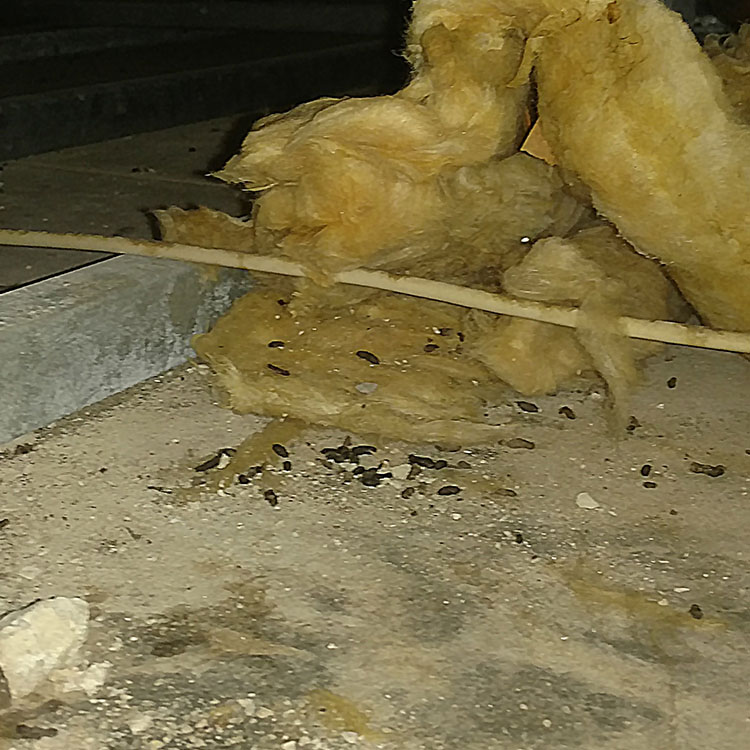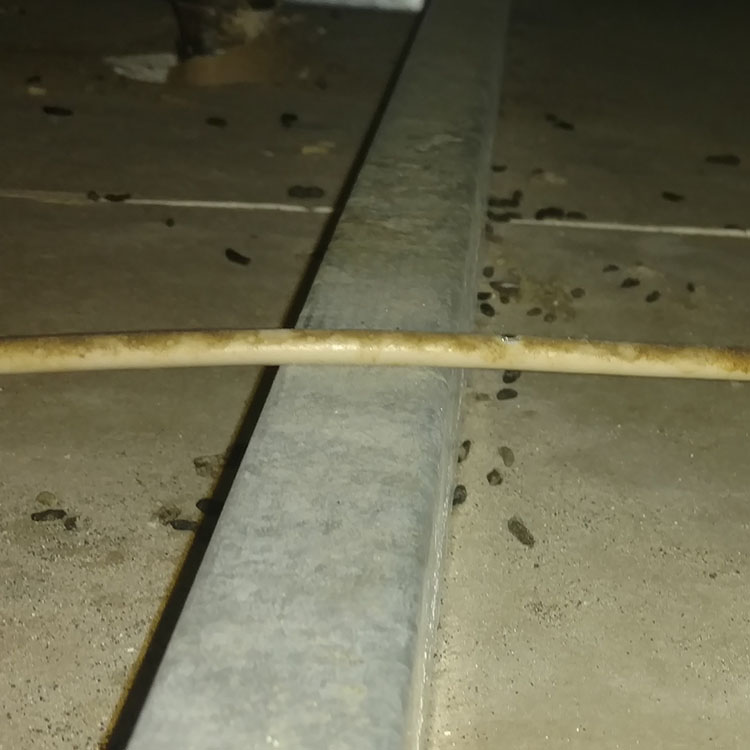Bat Poop

Did you just google Poop? Ha! Bet you never thought you would, but you did, so that must mean you have an issue with Bat Poop or are at the very least trying to figure out what is this feces that you found in your attic or around your home? But have no fear, I am the Poop Expert and will help you identify what droppings you may just be having an issue with! One of the biggest questions most customers ask me in the field is what kind of poop is this? How can I tell what kind of animal left these droppings in my attic? How do I know whether this poop is indeed bat feces and not opossum poop or squirrel poop or rat poop? There a lot of distinguishing factors when it comes to determining bat poop, as you can tell from the pictures on this page.
How big are Bat droppings? Bat poop is about the size of a staple and about 1-3 cm in length; Bat or Rat poop will look a lot like a black seed. Bat poop or Bat feces is generally black. If the Bat poop is very dry and brittle chances are that the Bat poop is not fresh. If the Bat Droppings are very soft and mushy then chances are it is very fresh. If you look at the dropping in the attic or around your house and you see a white tip at the end of the dropping that is more often a reptile dropping. But if you see the Bat droppings that look like seeds, a little oval, and there is no white at the end of it then you are more than likely dealing with Bats.

If you were trying to identify Bat poop or trying to figure out how you can tell if you do indeed have Bats in the attic (based on the poop that's on the insulation), you're going to look for the following distinguishing factors. Generally, Bat poop is about the size of a seed; it is about a half inch long and about 1-3 cm thick. Depending on the size and the age of the Bat that is in your attic, Bats also leave a lot of poop behind. I have been in attics that were completely covered. Bat breeding cycles are very fast and the population can grow astronomically. So, if you see a lot of feces in the attic or even just a little bit of Bat poop, you want to make sure you get on it very very fast. Most of the time when you have Bats in the attic, it's going to be a female that is pregnant and about to have her babies. Like I said earlier, the biggest giveaway with how to tell if it is Bat poop is going to be the size and color. Take a look at these pictures and they will help you identify which type of Bat you have in your attic or in the house.
Regardless of what animal your poop belongs to, you want to make sure that you DO NOT touch feces you find in your attic. You should call a professional for wild animal poop removal. If you do decide to remove poop you find in your attic without the assistance of a professional wildlife control team, you definitely want to make sure you have a respirator on because bat feces contain several different types of bacteria and insects that can harm you and potentially lead to death. One horrible health issue that stems directly from bat poop is roundworm. Roundworm, if ingested, leads to a variety of symptoms and can become fatal. Bat roundworm can become ingested by simply breathing it in if you are around bat feces. If you do not treat the roundworm that you ingest from bat poop, you can eventually die. There are also other bacteria affiliated with bat poop such as histoplasmosis and hantavirus, which are both diseases that can lead to severe respiratory issues.
Whenever Bats, opossums and squirrels poop, they will defecate wherever they're walking or flying. There is no rhyme or reason why Bats will only poop in certain areas collectively. The Bat feces will be all throughout the attic, in the insulation, under the insulation, everywhere, that is why you will need to sanitize the entire attic to eliminate any of the bacteria.

Another frequent question that customers call me and ask me about is what does bat poop smell like? To be honest with you, it smells exactly how it sounds terrible. Feces from bats have a very strong odor mixed in with urine, so the feces will start to smell like ammonia as well as rotting feces. Flies, larvae and other parasites will gather around this bat poop in your attic, so you want to make sure you're extremely careful. Remember that diseases can easily and instantly become ingested or inhaled from simple proximity with bat roundworm. Eggs can also be found in feces and urine from bats, which can also be inhaled. Larvae that is inside this parasite will start to affect the central nervous system of a human, causing diarrhea, dehydration and can lead to further health issues. For this reason, you should hire professional bat trappers and professional bat removal companies when dealing with bats in the attic. A professional bat company like Centurian Wildlife Control uses proper respiratory safety equipment, including hazmat suits, to protect the working technicians during bat feces removal. Professionals will remove the entirety of the bat poop and bat urine in the attic that safely to ensure the environment is clean and sanitized and prevent any inhalation of hazardous diseases. Once bat poop is removed by a professional wildlife control company, your bat trapper will sanitize the attic and all of the areas where the bat poop was in order to guarantee the safety of our customers, clients and family.
Bat droppings around your property, home, lawn or attic need to be removed immediately. Bat poop does smell; bats are wild animals that live outside. Bats also tend to defecate in residential, as well as lakes, rivers and ponds. If you find bat poop in any of these places or around your house or attic, stay away from it and make sure your dogs, cats and kids don't touch it, eat it or play with it. You do not want your children or pets to ingest any of the harmful bacteria and diseases that are affiliated with bat poop or bat urine. Excrement found in your attic commonly belongs to bats; if you think you may have an issue with bat infestation in your attic, please inspect the images on the left to confirm that what you have found indeed belongs to bats. You'll be able to get a good idea of what species you're found feces belong to. There are a lot of features of bat poop that makes it different than other animal feces, so please pay a lot of attention to these. These bat feces pictures will help you when trying to identify whether or not you are dealing with bats in your attic or bats pooping on your lawn.

2017 Updates on Identifying Bat Poop!
Bats much like myself and you have to use the bathroom, their feces are known most commonly as guano, which is quite rich in nitrate. However aside from being high in nitrate guano is one of the richest fertilizers in the world, being Texas's largest mineral export before oil! But, guano itself can also be immensely harmful causing diseases such as Histoplasmosis a type of fungal disease that can spore from fungi grown from guano. Breathing in the microscopic, airborne spores from the fungus can cause lung infections, which if left alone can spread to other organs such as the liver, or cause lasting damage to your lungs blood vessels and other parts of the body. The main people at risk here are Elderly, the youth and those with previous lung issues. Luckily Histoplasmosis is not contagious, so if somebody near you has it you won’t catch it, not from them at least.
Bat guano is generally small. To best get an idea for how small it is think of the tip of a pen, that tip will be around the size of Big Brown Bat droppings or eptesicus fuscus. While that may not seem like an area to be concerned about bats generally do tend to stick together and bats consume up to two-thirds of their body weight in insects daily. If you were to purchase guano for fertilization purposes you would notice that it looks something like pellet food for pets, but generally in dens it more closely resembles large bits of brown rice. But don't be fooled by this as guano itself has some minor corrosive properties that can harm drywall, and wood in your home, not to mention your stomach.

Bat guano sometimes can be described as having a shine to it, this is due to that mainly insect diet. Just like how corn can occasionally be seen in human poop left over exoskeleton will be in guano and cause it to have a translucent look to it. In dens or places, they've turned into dens, bats will pile their feces together making huge piles that can be large enough in some cases to cover attics.
If you think you are having an issue with bat poop and want to get an expert opinion, give me a call! My name is Brendan Mangnitz with Centurian Wildlife Control and I am always available to help identify what kind of feces you have found and would be happy to send one of our technicians out to assist you.
